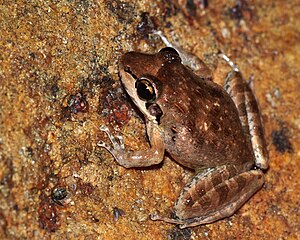Indirana beddomii
The Malabar leaping frog, Beddome's Indian frog, Beddome's frog, or Beddome's leaping frog (Walkerana beddomii) is a frog. It lives in India in the Western Ghat mountains.[2][3][1]
| Indirana beddomii | |
|---|---|

| |
| Conservation status | |
| Scientific classification | |
| Kingdom: | Animalia |
| Phylum: | Chordata |
| Class: | Amphibia |
| Order: | Anura |
| Genus: | Indirana |
| Species: | I. beddomii
|
| Binomial name | |
| Indirana beddomii (Günther, 1876)
| |
| Synonyms[2] | |
| |
Home
This frog lives on the ground near streams in forests that have at least some evergreen trees. It can live in forests that have been cut down and are growing back. People have not seen this frog on farms. People have seen this frog between 752 and 1200 meters above sea level.[2][1]
Young
The frog lays eggs on wet cliffs in cracks in rocks. This frog's tadpoles live in these cracks.[1]
Danger
Scientists believe this frog is in danger of dying out because it lives in a small place. Sometimes this frog dies on roads when cars and trucks hit it. People cut down the forests where it lives to build farms.dams, and other things that people need. Sometimes people hurt the frog by stopping landslides: the concrete people use to make roads stronger can fill in the cracks in the rocks where frogs would lay their eggs. Sometimes people go into the forest and cut some wood to use themselves, but this is only a little dangerous to the frog. It is possible that the sounds people make make it harder for the female frogs to hear the male frogs when they call to them.[1]
Scientists also think climate change could hurt this frog. Because it lives high in mountains, the frog cannot move north when the weather gets hotter the way other animals could. Climate change might also change the weather that this frog needs to lay eggs.[1]
Scientists have seen the fungus Batrachochytrium dendrobatidis on this frog, but they do not know how much danger the frog is in from the fungus. Batrachochytrium dendrobatidis causes the fungal disease chytridiomycosis.[1]
At least one of the places this frog lives is a protected park: Malabar Wildlife Sanctuary.[1]
References
- ↑ 1.0 1.1 1.2 1.3 1.4 1.5 1.6 1.7 Template:Cite IUCN
- ↑ 2.0 2.1 2.2 Frost, Darrel R. "Indirana beddomii (Günther, 1876)". Amphibian Species of the World, an Online Reference. Version 6.0. American Museum of Natural History, New York. Retrieved May 19, 2024.
- ↑ "Indirana beddomii (Günther, 1876)". AmphibiaWeb. University of California, Berkeley. Retrieved May 17, 2024.
